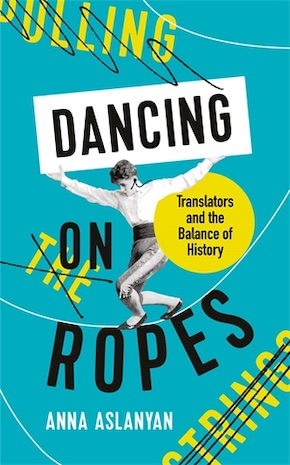Fifty per cent of Borges
by Anna Aslanyan
“A colourful tribute to the translators and interpreters slogging away throughout history, oiling – or clogging – the wheels of diplomacy and culture… Highly enjoyable.” Gaston Dorren, author of Lingo
“For nearly the past three years, I have been lucky to have my own translator by my side,” Jorge Luis Borges wrote in 1970, “and together we are bringing out some ten or twelve volumes of my work in English, a language I am unworthy to handle, a language I often wish had been my birthright.” Borges met Norman Thomas di Giovanni, a young and energetic American, while visiting Harvard in 1967, and their collaboration got off to a good start. Before returning to Argentina in 1968, the poet asked the translator to join him there so they could carry on working together. Six months later, di Giovanni was in Buenos Aires, ready to resume. He didn’t come empty-handed, having managed to secure a lucrative right-of-first-refusal contract with The New Yorker, whereby both of them would be paid equal sums for translations of Borges’ new work. Signing it was “like reaching nirvana in this world”, di Giovanni told me in 2010, adding, “Mind you, 50 per cent of Borges is not exactly an oil well.”
“Translation, in my workaday life, amounts to saying it in English,” di Giovanni writes in his memoir The Lesson of the Master. “Is it English? is the question I put to myself a hundred times a week.” He and Borges, himself a translator, both saw translation as a creative practice with plenty of opportunities for self-expression; they also believed that “words immediately suggested by the Spanish should be avoided in English”, showing a tendency towards, some would argue, overtranslation. In the poem ‘Everything and Nothing’, for instance, where Borges describes Shakespeare’s words as “copiosas, fantásticas y agitadas“, they rejected “copious, fantastic and agitated” (a version that appears in another translation; yet another uses “multitudinous, and of a fantastical and agitated turn”), rendering the phrase instead as “swarming, fanciful, and excited”. Dismissing “word-for-word slavishness”, di Giovanni states their idea of a good translation: “Aspiring to inconspicuousness, invisibility, [it] should bear no telltale trace of the original.”
A good translation is like a pane of glass. You only notice that it’s there when there are little imperfections – scratches, bubbles. Ideally, there shouldn’t be any.”
Their motto echoes the words of another American translator, Norman Shapiro, quoted by Lawrence Venuti in The Translator’s Invisibility: “A good translation is like a pane of glass. You only notice that it’s there when there are little imperfections – scratches, bubbles. Ideally, there shouldn’t be any. It should never call attention to itself.” Traditionally popular among translators working into English, this approach is the opposite of that promoted by Vladimir Nabokov, who wanted a translation to read like a translation. However, he didn’t always hold this view: at the beginning of his literary career, he translated Alice’s Adventures in Wonderland, renaming the heroine Anya and adding plenty of his own cultural heritage to her adventures. He cleverly reworked Carroll’s wordplay (in one of his puns, invented to replace “We called him Tortoise because he taught us”, he has an octopus going around with a rod, introduced purely for the sake of homophony) and substituted the original’s verses with parodies of well-known Russian poems – in other words, he thoroughly Russified the text. Reading this scintillating translation, you wish he hadn’t grown into such a pedant.
There were literalists among the ranks of Latin American academics too, and their reaction to the work of team di Giovanni–Borges was predictably intolerant. Years later, talking to me, di Giovanni was still fuming as he remembered his skirmishes with them.
They constantly picked on this word or that. In one story, we’ve got “he looked up to the sky”. The original says cielo, which in Spanish means both ‘sky’ and ‘heaven’. When we were working on it, Borges told me he meant the sky, so that’s what I wrote. And this academic got all het up: why did I say ‘sky’? The translation is signed by the author, but does it matter? No, they always know best.
I used to know another Argentine academic: she taught translation studies. If anyone wants to talk to you about translation studies, run for your life. So she says to me, “Di Giovanni, I’ve got a question for you. Borges’ story ‘Pedro Salvadores’ has 703 words, while your translation has 753.” That’s right, I say. She wants to know why. So I explain to her that such is the peculiar nature of the English language. She says, “OK, but here’s another thing I’ve noticed. Borges’ original is broken into four paragraphs, whereas you’ve got seven.” A crime has been committed!
What did he make of Borges’ famous story ‘Pierre Menard, Author of Don Quixote‘, I asked, and of its protagonist, whose “ambition, an admirable one, was to produce a handful of pages that matched word for word and line for line those of Miguel de Cervantes”? Quite how one can complete this impossible task is unclear, which makes it even more worth trying. A parable of translation, surely? “They often wanted me to do just that,” di Giovanni replied, “to turn into him and translate him word for word.”
The master, by contrast, was “unfailingly co-operative” and treated his collaborator with the utmost respect. When they first thought of a joint venture, Borges worried that adding his name as a co-translator would diminish di Giovanni’s status. Told that it would only raise the work’s standing, he said that in his country “a translator would be far too jealous to share credit with the author”. Later, discussing the terms of their contract with The New Yorker, di Giovanni was touched by Borges’ reaction to the fifty-fifty arrangement: “Is that enough for you? Perhaps you should take more.” Talking about their work in public, Borges was no less generous: “When we attempt a translation, or re-creation, of my poems or prose in English, we don’t think of ourselves as being two men. We think we are really one mind at work.”
Extracted from Dancing on Ropes: Translators and the Balance of History (Profile Books, £16.99)
 Anna Aslanyan is a journalist, literary translator and public service interpreter. She grew up in Moscow, lives in London, and feels most at home in books. Dancing on Ropes is published in hardback and eBook by Profile Books.
Anna Aslanyan is a journalist, literary translator and public service interpreter. She grew up in Moscow, lives in London, and feels most at home in books. Dancing on Ropes is published in hardback and eBook by Profile Books.
Read more
@anna_aslanyan
@ProfileBooks

